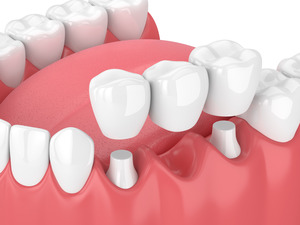
If you’re missing teeth and have looked into replacing them, you’re probably well aware that there are plenty of ways to do this. While the variety is certainly nice, it can also make it a little bit overwhelming to decide which method of tooth replacement is best for you.
For example, patients missing a few of their teeth will find that both partial dentures and dental bridges are appealing. If you want to know more about how to select between the two, here’s what you should know.
What Are Partial Dentures?
Dentures are famous for their ability to replace many teeth all at once, but this isn’t necessarily their only use. Partial dentures consist of an acrylic prosthetic attached to metal base, one that can hook onto the existing teeth. This allows partial dentures to effectively replace just a few teeth all at once.
Partial dentures can be structured as to replace about as many teeth as you’d like, even if they’re spread across a single gum ridge and divided by existing teeth.
What Are Dental Bridges?
Dental bridges consist of one or more false teeth sandwiched together. In the case of traditional dental bridges, these are connected to the natural teeth via dental crowns on either side of the simulated ones.
Dental bridges are typically made from an enamel-colored ceramic, which affords them remarkable strength and durability. The fact that they’re permanently adhered to the smile also gives them an incredible amount of bite power.
Which is Right for Me?
Each of these methods of tooth replacement have things going for them, and which one you should ultimately pick comes down to your individual situation. Dental bridges are stronger than partial dentures, affording a more powerful bite. They also don’t need to be removed for cleaning, which some patients tend to prefer.
However, partial dentures are capable of replacing several non-consecutive teeth at once, no matter where they are in the mouth. A single dental bridge, on the other hand, can only replace teeth that are right next to each other. Partial dentures also don’t require you to modify healthy teeth, which will be necessary for a dental bridge.
At the end of the day, a dentist would be able to tell you more about how each of these tooth replacement options could help you, and which best fits your needs.
About the Author
Dr. David Thomas prides himself on being his community’s “friendly neighborhood dentist,” someone that people can count on when they’re in need. He’s well aware of the psychological effect that missing teeth can have, so he loves being able to use his expertise to restore people’s smiles to perfection. Dr. Thomas received his degree from the University of Pittsburgh and completed his AEGD Residency at the Maricopa Institute of Health Services Hospital in Phoenix, AZ.
If you have any questions about missing teeth, he can be reached at his website or by phone at (206) 244-4622.



